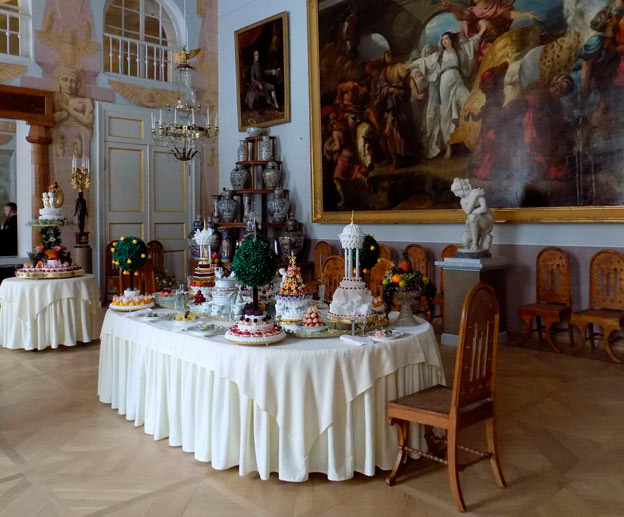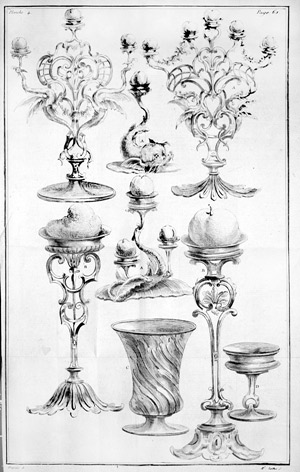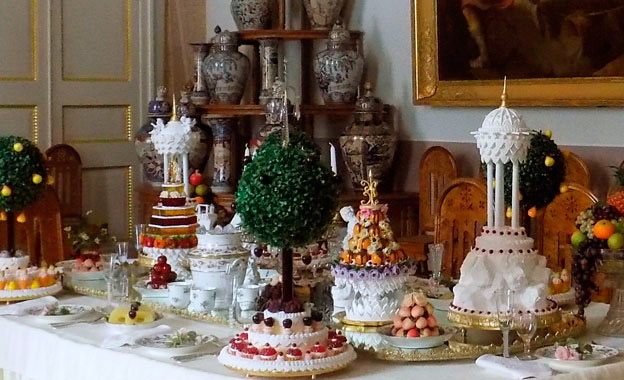Museum-estate of Prince Yusupov in Arkhangelsk gave its visitors the opportunity to see an exhibition of gala desserts, which were glorified by Russian writers, talking about dinners and Royal receptions. These desserts are made from natural ingredients and served like it is described in ancient books.
Often, coming to the Museum, we see the beautiful crockery, but in this case the Museum shows little-known but widely used in XVII-XIX centuries “natural” desserts. The organizers of the exhibition took care of the compliance with history in details. The historical setting is restored on the basis of the archive of the princes Yusupov, who owned Arkhangelsk in XIX century.
The author of all ten Museum exhibits-desserts is known master confectioner Aldis Bricevs. This is not his first experience of recreating the Haute cuisine of the past, he has already done more than 30 reconstructions for the Russian museums. The peculiarity of such exhibits, in addition to applying ancient techniques of manual preparation, is the requirement to conserve the desserts during all the exhibition.

«The Museum staff, says the Creator of the desserts chef Aldis Briches – has been so laboriously recreating the historical appearance of the dessert that they used even the cloth of the XIX century. It is a heavy tablecloth, which in those days was not stitched. The tablecloth is one of the three coverings of the table, in addition to the skirt and apron”. “These desserts, says Aldis, – could afford only wealthy people. According to sources, in 1900 in France one confectioner was paid (in terms of our money) $3 million per year, however, in contract was provided that he daily prepared desserts and never repeat it”.
The exposition represents tables with delicious desserts, ready for visitors, located at the Grand dining room, decorated in accordance with the books on gastronomy. The hall is in the form of a rectangular. It was painted in the late XVIII century with elements of ancient Egyptian art (pseudohypericin style), which became popular after the Egyptian campaigns of Napoleon, in the technique of grisaille (from FR. grisaille – grey, imitation of bas-reliefs from the extensive use of shades of one color).
According to N. L. Berezhnaya, deputy head of the sector of ceramics and glass at Museum-estate “Arkhangelskoe”: “Serving the dessert had to be the most stunning, it’s aim was to impress guests. Many of them were already full, and the dessert was primarily composed from fruits. The fruits have been a staple part of the dessert table. It was represented by fresh fruit, jams, marmalades, dried, sugared fruits, and so on, all types. Also ice cream was served. The purpose of dessert was to be remembered by the guests for a long time, or even forever. Sugar was imported, it was expensive and often was gilded, decorated with precious stones and was served on Golden and silver dishes. Silver was used less frequently, because it sometimes changed the taste of desserts. When in the XVIII century nobility began to use a porcelain, it was still rare and expensive that not even every European monarch could afford it”.
Dining room was well lighted with candles, chandeliers, additional lights. Its temperature should not exceed 16-20 degrees. The dining-room was furnished with chairs, mirrors, console tables and kitchen tables. During dinner the guests were delighted hearing the music provided by the musicians in the choir not visible to the them. In the wall was a slotted window that connected the dining room with pantry and served meals. The cutoff wall was hot from the oven, so food could not get cooled.

Tables were brought into the dining room just waiting for guests. The table was arranged in a U-shape, or could get florid (vincelette) form. There were boxes, covered with boards. On Board were placed the cloth – the tablecloth and serverbase, as a rule, crockery, often used silver. On the table was placed additional lighting. In the centre of the table a candelabra (XIX century) or irondale (XVIII century) was put too. The corners were exhibited the dishes. The estate Arkhangelskoe is well preserved of 5 or 3 vases.
The basis of the table was a large mirrored plateau (dish), where sugar, porcelain (Meissen, by the place of manufacture in Germany or the French “biscuit” soft porcelain) or papier-mache figurines were placed. Decoration was created on the theme of the feast. The use of sugar figures showed wealth because the cost of a pastry for their production was high, the majority of confectioners were foreigners.
High cake under the name “Imperial”, made by A. Brycevs, is the dessert of the reign of Nicholas I. Height of this cake reached 3 meters. Around the cake are located horns of plenty that could be made of sugar, marzipan or dough. In our case, it is gilded sugar. Aldis says, this is edible gold 23-carat, it was also used in beverages and desserts. Half a gram of the gold today costs about 7’000. Flower of sugar after molding must be dried up in 3-4 days. Glue for the sugar molded items were were whites of egg. Articles of jewelry made from dough were dried for 3-4 days and stored about a year. Sugar figures, made of a mixture of powdered sugar with vodka, were kept much longer.
«Cakes in those days, – says A. Bricevs – were not laid with jams and creams, as it is now, because otherwise the cake would fall apart. There were luscious cupcakes kugelhopf with raisins and candied fruit, which became better after a while. The dough served as binder, it was relatively few. Cakes had been fluffed with only a layer of hot jam, which put them together and then coated with cream outside. Since the King Louis XIV, same as in Roman times, it became fashionable to decorate cakes with gems. Around the cake you see Zephyr net, interspersed with 1’350 sugar pearls. All cake’s parts are edible».
Desserts “Rotonda” and the “pavilion of the Sultan,” using the rich sugar forms turm us back to the XVIII century. «For XVIII century trees were the most popular dessert type, – told us Nadezhda Berezhnaya, – they were decorated with marzipan fruits, and below there was a set of “edible” cakes, which treated the guests. Jelly cakes, which are located on the tables were also popular in that time.” In addition to marzipan for decorating sugar trees seasonal fruits could be used. Among the desserts we see the favorite delicacy of Louis XIV – profiteroles filled with cream and pate.

Jelly desserts, unlike our time, when technologies allows us to add weight and to get any monolithic shape, in those days they have been cut and glued from layers of jelly. Modern jelly and agar appeared in the XIX century and in the XVIII century the basis for jelly was fish glue. Originally jellies served in orange skins giving them flavor.
Ice-maker, lying on the table, is Sevres porcelain. French porcelain figured out the technology and from that moment use of porcelain dinner services became global.
“Yusupov cultivated pineapples, so we can see a pineapple in the center of the table – says Nadezhda, – People even came here to learn his experience, how it can be done in conditions of Russian winter. They were grown in heated greenhouses, usually guarded by the Germans gardener”.
Exhibition “Dessert at the Prince Yusupov” was opened in Arkhangelskoe on 18 may 2016, by due to the huge interest of the visitors it was extended to 31 March 2017. Perhaps if the Museum will have the opportunity, before the end of the exhibition Aldis Brycevs will make a master class on cooking of delicious desserts.
Cultural-political magazine “E-Vesti” would like to thank Nadezhda Berezhnaya and Aldis Bricevs for interesting material, which was provided for the article.






